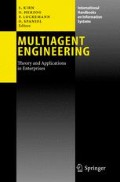Abstract
The structures in health care are currently changing. Clinical management and physicians have the obligation to both ensure quality of care and to work more cost effectively. The optimization of the system respecting these contrary goals is a big challenge. New information technology and computer applications like adaptive agent based assistance agents may be one way to optimize the system. Additionally organizational changes regarding resources or processes may also enhance the system. In many cases the effects of optimization ideas are difficult to foresee. This chapter describes the possibilities of multiagent simulation for experimentation and optimization of adaptive scheduling in hospitals. It presents a specialized agent based construction kit for hospital simulation and describes the results of realized example scenarios.
Access this chapter
Tax calculation will be finalised at checkout
Purchases are for personal use only
Preview
Unable to display preview. Download preview PDF.
References
Alvarez, A. M.; Centeno, M. A.: Enhancing simulation models for emergency rooms using vba. In: Proceedings of the 1999 Winter Simulation Conference.
Blazewicz, J.; Ecker, K.; Pesch, E; Schmidt, G; Weglarz, J: Scheduling Computer and Manufacturing Processes. Springer, 1996.
Decker, K.; Li, J.: Coordinated Hospital Patient Scheduling. In: Proceedings of the Third International Conference on Multi-Agent Systems, (ICMAS98). Paris, France, July 1998, pp. 104–111.
Decker, K.: Taems: A framework for environment centered analysis & design of coordination mechanisms. In: O’Hare, G.; Jennings, N. (Eds.): Foundations of Distributed Artificial Intelligence, Chapter 16. Wiley Inter-Science, 1996, pp. 429–448.
Erdem, H. I.; Demirel, T.; Onut, S.: An Efficient Appointment System Design For Outpatient Clinic Using Computer Simulation. In: Proceedings of the 2002 Summer Computer Simulation Conference.
Ferber, J.: Multi-agent Systems. Introduction to Distributed Artificial Intelligence. Addison-Wesley Professional, 1995.
Herrler, R.; Heine, C.: A4care: Persönliche Assistenzagenten für die Klinische Pflege. In: Künstliche Intelligenz 19(2004)3, pp. 56–58.
Herrler, R.; Heine, C.: The adapt toolkit-supported engineering process for agent based applications. In: Proceedings of the Tenth Americas Conference on Information Systems (AMCIS 2004). New York, 2004, pp. 1794–1805.
Herrler, R.; Heine, C; Klügl, F.: Appointment scheduling among agents: A case study in designing suitable interaction protocols. In: AMCIS 2002 Proceedings, Dallas, pp. 1456–1463.
Herrler, R.; Puppe, F.: Computerunterstützte, doppelt interaktive Schichtplanung für Pflegepersonal. In: Abstraktband des Internationalen wissenschaftlichen Kongress für PflegeInformatik ENI2004. Innsbruck, 2004.
Hestermann, D.: Wizard: A system for predictive, reactive and interactive multi-resource scheduling. In: Proceedings der Konferenz Planen und Konfigurieren (PuK 1999).
Jennings, N. R.: On agent-based software engineering. In: Artificial Intelligence 177(2000)2, pp. 277–296.
Klügl, F.; Oechslein, C.; Puppe, F.; Dornhaus, A.: Multi-Agent Modelling in Comparison to Standard Modelling, In: Simulation News Europe 40(2004), pp 3–9.
Klügl, F.; Herrler, R.; Oechslein, C.: From simulated to real environments: How to use SeSAm for software development. In: Schillo, M. (Ed.): Multiagent System Technologies-1st German Conferences MATES (LNAI 2831), 2003, pp. 13–24.
Klügl, F.; Oechslein, C.; Puppe, F.; Dornhaus, A.: Multi-agent modelling in comparison to standard modelling. In: Giambiasi, N.; Barros, F. J. (Eds.): AIS’2002 (Artificial Intelligence, Simulation and Planning in High Autonomy Systems), pp. 105–110.
Klügl, F.; Puppe, F.; Raub, U.; Tautz, J.: Simulating multiple emergent behaviors-exemplified in an ant colony. In: Adami, C.; Belew, R.; Kitano, H.; Taylor, C. (Eds.): Proceedings of Artificial Life VI, Los Angeles. MIT Press, 1998.
Miksch, S.; Shahar, Y.; Johnson, P.: Asbru: A task-specific, intention-based, and time-oriented language for representing skeletal guidelines. SMI Technical Report No. SMI-96-0650, 1996.
Ouelhadj, D.: A Multi-Agent System For The Integrated Dynamic Scheduling of Steel Production. PHD-Thesis, University of Nottingham, August 2003.
Parker, M. T.: What is Ascape and why should you care? In: Journal of Artificial Societies and Social Simulation-JASSS 4(2001)1.
Paulussen, T. O.; Zöller, A.; Heinzl, A.; Pokhar, A.; Braubach, L.; Lamersdorf, W.: Dynamic patient scheduling in hospitals. In: Coordination and Agent Technology in Value Networks. Multikonferenz Wirtschaftsinformatik, Agent Technology in Business Applications. Essen, 2004.
Pinedo, M.: Scheduling: Theory, Algorithms and Systems. Prentice-Hall, New Jersey, 1995.
Riley, L. A.: Applied simulation as a decision support system tool: The design of a new internal medicine facility. In: Proceedings of the 32nd Hawaii International Conference on System Sciences, 1999.
Sauer, J.: Knowledge-based systems in scheduling. In: Leondes, C. T. (Ed.): Knowledge-Based Systems: Techniques and Applications. Academic Press, San Diego, pp. 1293–1325.
Schmidt, G.: Scheduling with limited machine availability. In: European Journal of Operational Research 121(2000), pp. 1–15.
Sibbel, R.; Urban, C.: Agent-Based Modeling and Simulation for Hospital Management. In: Saam, N. J.; Schmidt, B. (Eds.): Cooperative Agents, Applications in the Social Sciences. Dordrecht, Boston, London, pp. 183–202.
Wooldridge, M.; Jennings, N. R.: Intelligent agents: Theory and practice. In: The Knowledge Engineering Review 10(1995)2, pp. 115–152.
Author information
Authors and Affiliations
Editor information
Editors and Affiliations
Rights and permissions
Copyright information
© 2006 Springer Berlin · Heidelberg
About this chapter
Cite this chapter
Herrler, R., Puppe, F. (2006). Adaptivity and Scheduling. In: Kirn, S., Herzog, O., Lockemann, P., Spaniol, O. (eds) Multiagent Engineering. International Handbooks on Information Systems. Springer, Berlin, Heidelberg. https://doi.org/10.1007/3-540-32062-8_15
Download citation
DOI: https://doi.org/10.1007/3-540-32062-8_15
Publisher Name: Springer, Berlin, Heidelberg
Print ISBN: 978-3-540-31406-6
Online ISBN: 978-3-540-32062-3
eBook Packages: Computer ScienceComputer Science (R0)

